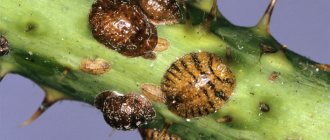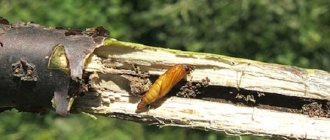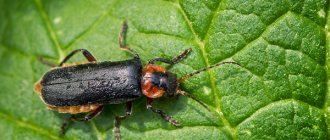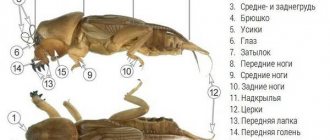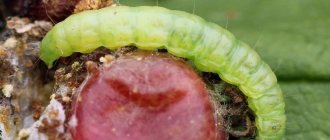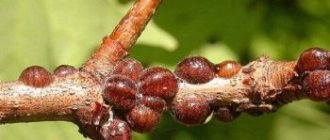Currants are unpretentious and can grow in almost any soil. In order to get good harvests, it is necessary to carry out the usual agrotechnical practices in a timely manner - watering and feeding. Regular pest and disease control is necessary. Representatives of the currant family can be damaged by more than 70 species of insects. Often, scale insects are found on berry bushes - a sucking pest that feeds on the juices of branches, leaves and shoots. This dangerous insect can destroy all the currant bushes in the garden if you do not take action and start fighting it in a timely manner.
Description of the pest
Scale insects belong to the coccids, a superfamily of insects. There are many known species of this representative of the order Hemiptera; currants are attacked by:
- Comma-shaped scale insect.
- Willow scale insect.
- Acacia false scale.
They differ in size and color; a common feature is the presence of a dense wax shield that protects the body of an adult pest. The false scale insect, unlike the ordinary scale insect, easily parted with its shell.
Female coccids are capable of bearing huge offspring without the need for fertilization. Having laid eggs, she dies, and the “armor” left behind by the female protects the offspring from destruction.
The false scale insect lays eggs after the currant blossoms.
After overwintering, the pest hatches from eggs in May–June, when apple trees begin to bloom. The emerging larvae are called “strays” and are less than a millimeter in size. The larvae crawl throughout the plant, looking for a suitable place to feed.
Heavy rain significantly reduces the number of “vagrants”.
Pests prefer leaves, located on their veins on the inside and outside. Scale insects can often be seen on stems and trunks. The stuck “tramp” is undergoing changes.
Most of the larvae turn into females. The role of males in procreation is insignificant, so few of them are born.
The female larva can no longer move, and a waxy shell begins to grow around her body. The older the pest, the denser its shell. Females have a well-developed oral apparatus of the sucking-piercing type, but lack eyes and organs of locomotion. Males can move, but they are deprived of the opportunity to feed.
Pests feed on plant sap, absorbing proteins from it. The honeydew they secrete, a sweet sticky secretion, is clearly visible on the plants.
Honeydew attracts ants.
What does it look like
Pests covered with waxy shells resemble scales. The “armor” of pseudoscale insects is yellowish-brown; other representatives of coccids have shells painted in grayish shades.
Large colonies of pests are often mistaken for ordinary growths on the trunk.
What harm does currants cause?
Scale insects feed on plant juices, weakening them. This leads to a decrease in yield and the death of currant shoots. If the pest is not controlled, it can completely destroy the bush.
Symptoms of the lesion
The little larvae are difficult to notice with the naked eye. When the pest becomes active, traces of its activity will be obvious:
- Sticky spots on currant leaves.
- Dense plaques on different parts of the bush.
It is necessary to inspect the lower parts of the leaves and the places where the leaf cuttings adjoin the branch.
Consequences
Once in favorable conditions, insects can completely occupy the currant bush. They suck out the nutritious juice, causing premature yellowing and shedding of the leaves.
The plant does not develop, the quality of the fruit deteriorates. If measures are not taken, the weakened plant will not be able to prepare for the next growing season and will die.
The absence of frost in winter and extremely hot summers are ideal conditions for the spread of scale insects.
What harm does it do?
Scale insects are very dangerous pests that can destroy entire currant plantations in a few years. In production, if a large number of these pests are detected, strict quarantine is introduced with a ban on the export of berries and seedlings.
Currant buds end up on bushes along with imported seedlings, purchased soil, or through the “vagrant” method (wind, rain, animals, etc.).
These pests are capable of sucking out all the cell sap of leaves, young shoots and even berries. If you do not take any measures to combat scale insects, this threatens the complete death of the plants.
The leaves and shoots on the currant bushes will gradually dry out, eventually the bush will die, and the scale insects will move to another plant.
How to fight and get rid of scale insects on currants
A kind of armor reliably protects adult pests and their eggs. Therefore, different methods are used to combat them:
- mechanical;
- chemical;
- folk remedies.
If there are few “shields” on the bush, you can try to remove them mechanically, peeling them off the branches and leaves. You need to put a newspaper under the bush in order to later destroy the pests that have fallen on it.
You can put a rubber glove on your hand, and on top pull a cloth mitten moistened with soapy water.
For chemical control, systemic pesticides and insecticides that can penetrate the protective shield are suitable. These drugs are recommended for use at the beginning and end of the growing season.
Folk remedies work well as long as the pest is not protected. They can be used throughout the growing season.
The time of emergence of larvae from eggs is somewhat different for different types of scale insects. From mid-May to mid-July, you need to regularly inspect the bushes in order to promptly identify “shields” in the initial stage of their formation.
Processing rules:
- In the morning or evening hours.
- No rain is forecast for the next 4 hours after spraying.
Chemical
Just one treatment with a properly selected drug will help get rid of scale insects. The choice of chemical depends on the processing time:
- Systemic drugs are used in the spring.
- Ovicidal drugs are used in spring and autumn.
Treatment is carried out at an air temperature of at least 4 °C. Use a freshly prepared solution.
Intraplant (systemic) drugs penetrate into the cell sap of the plant. The larva, feeding on plant sap, receives a portion of poison and dies. After treatment, the toxin circulates in the plant tissues for about a month.
Systemic drugs include pesticides from the neonicotinoid group:
- Aktara;
- Tanrek;
- Colorado;
- Apache.
Systemic preparations are used for spraying and watering plants.
Ovicidal drugs are destructive to insect eggs. Organophosphate pesticides have this property. For processing currants it is recommended:
- Actellik.
It is not recommended to use the same product twice in a row.
Aktellik
A very strong toxic drug. It contains pirimiphos-methyl and is classified as an organophosphorus compound. Actellik is a pesticide of fumigant and enteric contact type. The poison penetrates the body's cells through the respiratory tract, insect integument and intestinal tract. Affects oviposition. The insect dies within a few hours.
The drug is sold in the form of an emulsion in ampoules of 2–5 ml. Dosage for spraying:
- 2 ml per 2 liters of water.
Droplets of the emulsion, falling on the shell of the scale insect, are able to penetrate through it and infect the pest and its eggs.
Disadvantages of the drug:
- unpleasant odor;
- Toxicity class 2, protective measures are required during processing.
Aktara
A systemic neonicotinoid insecticide contains imidacloprid. The poison infects the insect through the esophagus when it feeds on the juices of the plant.
The substances included in the preparation ensure translaminar transport of imidacloprid - it quickly enters all parts of the plant and remains in them for a long time.
The drug penetrates the plant through the roots, leaves and bark. It blocks the transmission of nerve impulses in muscle tissue. The insect stops feeding and quickly dies from exhaustion.
The scale insect dies within two days after treatment.
Aktara against the Colorado potato beetle and other pests is sold in powder form in packages of 4 grams and in ampoules containing 1.2 ml of emulsion. The working solution is prepared at the rate of 1 g of powder or 1 ampoule per 1 liter of water. Currants are sprayed and the ground is watered in the root circle.
The insecticide is dangerous for bees. You can spray only before flowering.
Tanrek
This systemic insecticide is used for spraying and watering. It contains imidacloprid, which has a paralyzing effect on the pest. Read about the instructions for using tanrek against pests here.
It is analogous to Aktara.
Tanrek is sold in ampoules that contain 1 ml of the substance. To prepare a working solution, it is diluted in 2 liters of water. Currants are sprayed and watered in early spring.
Colorado
A systemic insecticide containing imidacloprid as an active substance. Its effect on pests is similar to Aktara.
The drug is available in different packages; the spray solution is prepared based on:
- 1 ml of Colorado per 5 liters of water.
Apache
This systemic insecticide of the latest generation is characterized by economical consumption and high efficiency. Apache contains clothianidin, which has a paralyzing effect on the pest half an hour after contact with it. Read about Apaches from the Colorado potato beetle.
The release form of the drug is granules, packaged in 0.5 gram bags. One package contains 5 sachets. Scheme for preparing the solution:
- 1 g per 1 liter of water.
Folk remedies
Environmentally friendly folk remedies can be used throughout the growing season. They have more of a preventive effect.
Decoctions can be stored for a month in a cool place. Infusions must be used within a week.
You can spray the plant with the prepared solutions and wash it. Treatment should be carried out twice a week for a month.
These remedies work if the plant is only slightly infected. With a massive invasion of scale insects, only “chemistry” will help.
Tobacco dust
The drug, made from tobacco production waste, contains many useful elements (nitrogen, potassium, phosphorus) and the poison nicotine.
Tobacco dust can both fight pests and nourish the plant, increasing its immunity.
Preparation of infusion for spraying:
- Pour 80 g of tobacco dust into 1 liter of hot water.
- Leave for a day.
- Before use, add liquid soap or washing powder.
If there is no tobacco dust, you can infuse cigarette butts.
Laundry soap
A soap and oil solution helps to cope with scale insects. It creates a film that makes it impossible for the insect to breathe. Preparation of the solution:
- 1 part soap solution and 3 parts sunflower oil.
To obtain a soap solution, 30 g of soap must be dissolved in a liter of hot water.
The resulting emulsion must be applied to the leaves and shoots of currants for 10 hours, and then washed off with water. It is advisable to repeat this procedure after a week. Treatment should be carried out in the morning on a cloudless day. Read how to dilute laundry soap against aphids on currants here.
When carrying out early spring scalding, you can dissolve 100 g of grated soap in 10 liters of hot water. After the procedure, you need to “clean” the currant branches with a toothbrush.
Green soap
Green soap contains potassium salts of fatty acids, animal and vegetable fats. When spraying currants, a dense film is formed on its parts, which impedes the life of the scale insect. It is advisable to carry out the treatment twice with a period of 7 days with a solution containing:
- 50 g of soap in 10 liters of water.
Some gardeners claim that there is no need to wash off the composition from the bushes. Night dew and rain will wash away the currants.
Garlic solution
Garlic is traditionally used to control pests. The fungicides contained in this vegetable repel insects. To prepare the infusion use:
- 10 chopped garlic cloves;
- A glass of warm water.
Leave for two days, then treat the bush.
You can add soap, green or laundry soap, to the infusion for better adhesion.
Wood ash
Caustic alkali, resulting from the dissolution of ash in water, has a detrimental effect on young scale insect larvae. Preparation:
- Pour 300 g of ash with a liter of boiling water.
- Boil for half an hour.
- Dilute the decoction in 10 liters of water.
Pepper infusion
Pepper contains alkaloids, the strongest biological poisons. First you need to prepare a decoction of hot pepper:
- Boil 50 g of fresh or 10 g of dry material in 500 ml of water.
Then the decoction must be infused for 24 hours. To prepare the working solution you need to use:
- 1 tbsp. a spoonful of infusion;
- 1 liter of water;
- 1 tsp. liquid soap.
Methods for combating scale insects in the garden
It is very difficult to exterminate scale insects, because adult individuals are protected by a durable chitinous shell, and most toxic chemicals do not affect them. As a result, they can only be removed by hand from tree bark.
Scale insects on plums, cherries and other fruit trees are scraped from the bark using a metal brush or a special scraper, and adult females must be destroyed along with the laid eggs. In case of severe irreversible damage, dead branches are pruned and burned.
Methods of combating garden scale insects.
Scatterings of scale insects found on seedlings are removed mechanically, and the branches are additionally washed with a solution of laundry soap. They fight the parasite in the same way on decorative indoor plants.
But young larvae, especially during their mobile period, are susceptible to the action of pesticides.
Before you start fighting scale insects on cherries and other fruits, you must consider the following rules:
- Water the surrounding plantings well;
- It is recommended to first try non-toxic control methods;
- spraying with a soap solution can be done no more often than once every 7 days, it is better to use mild liquid soap;
- To increase effectiveness, the drugs should be used alternately.
Treatment of garden trees against false scale insects.
After scraping, the tree must be treated with insecticides. Experts recommend the following drugs:
- Actellik is an emulsion for controlling garden pests; it is not addictive, but is dangerous for animals and people because it has a pungent odor;
- Aktara is a highly effective product, dangerous for bees, not used in residential areas;
- Bitoxibacillin is a preparation with live bacteria, safe for people and animals, there is no odor, but the treatment must be done several times. Valid only at air temperatures above +18˚С;
- Preparation 30 is an environmentally friendly product, used in the spring before flowers appear on the trees.
Important! When using all of the above products, be sure to wear protective clothing, a respirator and gloves to avoid poisoning.
Prevention
Scale insects are often brought into the garden along with new planting material. Purchase currant seedlings only from a trusted supplier. Pests prefer to settle on weakened plants that cannot resist them. The appearance of scale insects is a signal of unfavorable conditions for growing currants. This material will tell you how to process currants in the spring.
Agrotechnical measures
To protect currants from scale insects, you must follow a number of rules:
- Buy healthy seedlings.
- Don't overfeed with nitrogen.
- Dig up tree trunk circles.
- It is better to cut off severely affected branches and burn them.
- Remove fallen leaves and burn them.
- Carry out preventive spraying against pests.
Plant enemies
Scale insects do not disdain to feed even on poisonous plants; they have no enemies in the plant world. But several dozen insects are ready to live at its expense. These include:
- Predators: ladybug and chilocorus beetle.
- Parasites of the genus Aphytis.
Chilorus awakens from hibernation in April. It gnaws through the coccid's scutes and lays its eggs under them. Ladybugs hibernate under fallen leaves. They also prefer to lay their eggs under the shell of the scale insect.
Parasitic Aphytis parasites place their eggs on the body of the scale insect. The hatched larva feeds on the body of its mistress, and goes to winter under her shield. Read about glassware on currants in this article.
Chemical means of protection destroy not only the scale insect, but also its natural enemies - insects.
It is difficult to maintain a balance of harmful and beneficial insects in order to provide biological protection to currants. Populations of beneficial organisms can be attracted to the garden by planting the following plants:
- Tansy.
- Marigold.
- Caraway.
- Dill.
- Buckwheat.
Tansy and dill attract ladybugs. Equestrians feed on buckwheat nectar. Marigolds and caraway are attractive to small wasps. They feed their larvae with larvae of harmful insects.
Symptoms of the lesion
If the larvae can only be seen under a magnifying glass, then the consequences of their “feeding” and development are easy to detect. The foliage on the plants becomes sticky and shiny, as if they had been smeared with honey. Already at this stage it is too late to start fighting; usually the scale insects are covered with protection. The coating tastes sweet, this is due to the release of sweet and sticky waste by the feeding “vagrants”.
Then the shoots and trunks become covered with a grayish coating; due to a lack of nutritious sap, the plant begins to lag behind in development, the foliage becomes small and gradually dries out. The plant’s nutrition from photosynthesis processes is disrupted and, in fact, the plant stops “breathing” through the foliage. Early leaf fall begins, the bark on the trunks and shoots cracks and bends.
Consequences
A gardener who does not carry out preventive treatments against scale insects on currants and other garden plants risks being left without a harvest and will lose seedlings altogether. If at the beginning, due to insufficient nutrition, parts of the bush are depressed, then later the lack of nutrition causes the shoots and trunks of the bush to dry out.
It is not always possible to reliably protect the garden, even if all preventive treatments are carried out, if the neighboring area is abandoned or not treated for pests. In this case, active males and “vagrants” will quickly fill the neighboring garden and young females will hatch in August.
Read also: Pygmy (currant) variety: description, photos and reviews
Resistant varieties of black and red currants
Scale insects attack mainly weakened plants. By purchasing zoned varieties with complex resistance to pests and diseases, you reduce the chances of scale insects breeding in your garden. This link will tell you about the Selechenskaya currant variety.
Table: Resistant blackcurrant varieties
| Name | Ripening period | Tasting assessment |
| Summer resident | early | 4,7 |
| Selechenskaya 2 | early | 5,0 |
| Izyumnaya | early | 5,0 |
| Temptation | average | 5,0 |
| Charm | average | 4,5 |
| In memory of Pavlova | average | 4,4 |
| Veloy | late | 5,0 |
Table: Resistant red currant varieties
| Name | Ripening period | Tasting assessment |
| Vika | early | 4,5 |
| Gazelle | early | 3,5 |
| Jonckheere van Tets | early | 4,0 |
| Scarlet Dawn | average | 4,5 |
| Alpha | average | 4,7 |
| Ilyinka | average | 4,8 |
| Natalie | average | 4,0 |
| Lights of the Urals | average | 4,5 |
| Ural beauty | average | 5,0 |
| Dutch red | late | 3,5 |
| Gift of summer | late | 3,5 |
Spider mite
It is difficult to notice spider mites on currants, since they are very small. Due to its vital activity, the leaves lighten, light spots remain on them, then the leaf becomes marbled, gradually dries out and falls off. Because of this, the currant bush’s immunity and cold resistance decrease, and its yield decreases.
Control measures: spraying currants with Fitoverm (2 ml of the drug per 1 liter of water, 1 liter per bush) after flowering, or with infusions of wormwood and tobacco, and after harvesting the currants with Karbofos (60 g per 10 liters of water).
conclusions
- Scale insects and bud mites are often brought into the area with planting material.
- The pest prefers to settle on weakened plants.
- Compliance with the rules of agricultural technology will increase resistance to harmful insects.
- Folk remedies are used prophylactically throughout the growing season.
- Chemical pesticides can be used in early spring and late autumn.
- If there are too many pests, you can trim the bush to zero and treat it with chemicals.
- Buy varieties with complex resistance, such as Dachnitsa, Selechenskaya 2, Jonker Van Tets and others.
Gallica
Gall midges are insects similar to mosquitoes, adults are yellow-brown in color, 2-3 mm long. All above-ground parts of currants are affected, usually young bushes; there are 3 types - stem, leaf and flower. The difference between them is where the gall midge is located on the currant, i.e. where its larvae feed:
- Stem - forms large colonies under the bark of stems. At the site where the caterpillars invade, swellings—galls—appear as a consequence of tissue proliferation. In this place, the bark dies, which is why the shoots die (up to 70% in case of massive damage). The flight of adults begins during mass flowering.
- Leafy - the larvae feed on young currant leaves (with juices and scraping the upper skin), causing them to stop developing, curl and die, as a result of which shoot growth stops. Flight occurs at the beginning of flowering.
- Floral - found in flower buds that look like a ball or pear. The flowers acquire a reddish color and fall off without producing ovaries. The flight of the imago begins during the budding period.
Grown larvae of all types descend to pupate in the upper layers of the soil. Three to four generations may develop during the growing season. The first generation pupates in the spring. Adults of the second - fly out towards the end of flowering. Gall midge larvae overwinter in the soil. In the spring, after warming, they come up and pupate.
Gall midge caterpillars are initially colorless, then whitish, after which they change color to red-orange. The body shape is flattened.
Control measures: spraying the bushes and the soil around them before flowering with insecticides (for example, Karbofos), and during the growing season with biological preparations (for example, Fitoverm).
You can also use folk remedies, for example, infusions of any of the plants: chamomile, walnut leaves, henbane, tansy, yarrow. You need to take 300 g of raw materials and leave them in a bucket of hot water for a day.
